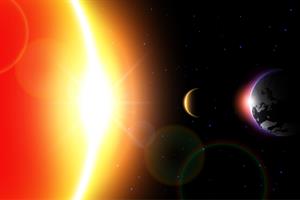PDF chapter test TRY NOW
In certain cases, motion is observed indirectly. For example, the movement of dust and leaves on a tree denotes the flow of air from one place to another; the wonderful phenomena of sunrise and sunset show the Earth's rotation, and the change of seasons every year shows the motion of the Earth around the Sun.

Motion of the Earth around the Sun
While travelling on a train, the trees on the sides seem to be moving backwards. Have you ever noticed this? If so, do you think the same will apply to a person standing near the tree?
The answer will be, NO!

Moving trains
When we are sitting on a train that is actually at rest, sometimes it appears to move. As motion is relative, if the objects outside the train move, our eyes perceive it in a way that we are moving.
An object can appear to be moving for one person, while it seems to be stationary for another. Hence, motion is a relative phenomenon.

A moving bus
Now we know the motions are relative; then let us see the classifications of the motions.
S. No | Type of motion | What is it? | Example |
1. | Linear motion | The object moves along a straight line. | A car travelling in straight road. |
2. | Circular motion | The object travels in a circular path. | Movement of artificial satellite orbiting the earth. |
3. | Periodic or oscillatory motion | Objects that are in repeated motion for equal intervals of time. | The pendulum of a clock. |
Motions are complex sometimes. Objects may move in a straight line or a circle. Sometimes, it may rotate or even vibrate. In certain situations, it can be a combination of all of these.
